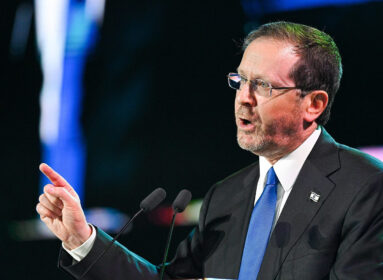NEW HAVEN – “It is not the strongest species that survive, nor the most intelligent, but the ones most responsive to change.”
That quote, attributed to Charles Darwin (albeit hotly debated for its accuracy and intention), is how Mark Sklarz rolled out to community groups the new Jewish population study commissioned by the Jewish Federation of Greater New Haven. Sklarz is president of the Federation’s board of directors, which is working with the demographic study committee.
This is the first scientifically documented study of the greater New Haven Jewish community; an abbreviated study was conducted in 1985. The survey represents Step One in the Federation’s comprehensive strategic plan, launched as a way to assess the needs of a changing Jewish community, Sklarz says. “We wanted to understand the population itself in terms of numbers, the geographic spread of the population, where the density occurs, where the families live, the ages, the nature of the families, affiliations, familiarity with Jewish agencies and institutions, and the priorities people have,” he says. “We want to understand their goals, objectives, and needs, and assemble those into a logical form to see how it all fits into our community goals.”
Now the Federation will conduct a range of community meetings so that community members, lay leaders, and federation leaders can review and discuss the data. In six months time, the strategic planning committee hopes to have a plan that reflects a structure for the community. “This is a watershed moment because we’re going to be able to respond to changes in the Jewish community and Jewish continuity,” Sklarz says.
“We spent a lot of money on this study and our thought is that it would help the entire community, because none of our agencies that need such a study has the funding to do one,” says Sydney Perry, CEO of the Jewish Federation of Greater New Haven. “We didn’t truly know our community – even those of us who grew up here – until we saw the study. We didn’t want to be satisfied with the status quo, and this was the only way to begin to responsibly address our community’s needs.”
The New Haven Jewish population study is housed at the Berman Institute North American Jewish Data Bank, the central repository of social-scientific studies of North American Jewry. A collaborative project of the Jewish Federations of North America and the University of Connecticut’s Center for Judaic Studies and Contemporary Jewish Life and Roper Center for Public Opinion Research. Prof. Arnold Dashefsky, director of the University of Connecticut Center for Judaic Studies and Contemporary Jewish Life, is director of the Berman Institute North American Jewish Data Bank.

Full reports can be found at the North American Jewish Data Bank, www.jewishdatabank.org.
Among the data bank’s holdings – many of them available online – are questionnaires, reports, and data files from the National Jewish Population Surveys (NJPS) of 1971, 1990 and 2000-01, sponsored by United Jewish Communities (now Jewish Federations of North America). The data bank is the sole distributor of the NJPS 2000-01 dataset, and has archived a large collection of related materials.
Greater New Haven is the third Connecticut Jewish Federation to conduct a major Jewish population survey in the past decade. The Jewish Federation of Greater Hartford canvassed its catchment region in 2000, and UJA/Federation Westport Weston Wilton Norwalk (WWWN) commissioned a study in 2001. The three surveys were led by Dr. Ira M. Sheskin of the University of Miami, a faculty member of the department of geography and regional studies, and director of the Jewish Demography Project in the Sue and Leonard Miller Center for Contemporary Judaic Studies.
The data provide a valuable way to grasp the make-up of a community, but must be used in a timely fashion, says Steve Friedlander, executive director of UJA/Federation WWWN since 2004.
“The study established a benchmark for known areas of interest and involvement in the community,” he says. “But that has to be balanced against the reality that, particularly in the past 10 years, transitions in our culture have accelerated very quickly. The population study is a snapshot of a particular moment in time and its shelf-life is no longer the same as it would have been in the past. It’s fine to take that snapshot, but if you don’t keep pace with it somehow, the data become archival.”
Many Jewish communities would like to conduct such a study, Dashefsky says, but the biggest challenge is cost: a social-science survey that reveals an accurate count of the community can run into six figures. While a Jewish Federation may have access to information on affiliated Jews, it’s the unaffiliated that these surveys are meant to identify, in order to get an accurate portrayal of the population.
A community wants to assess the geographic dispersion of the Jewish population, its age distribution, and the likely needs of different groups, in order to assess the various services it might provide, Dashefsky says. The 2000 Greater Hartford study revealed a large enough population of young families to consider establishing a Jewish preschool. The survey discovered a growing concentration of Jews in the western suburbs, which led to the creation of the Federation’s Chai Center for Jewish Life in Avon. Chabad of the Valley expanded its activities in the area, and Big Y Foods increased its kosher offerings.
“In the Jewish community, there’s always something to worry about, a crisis about to erupt, a threat to our survival,” says Sydney Perry. “There’s a joke about the text of an emergency alert from a Jewish Federation: ‘Start worrying; details to follow.’ We will not allow ourselves to fall into a situation of not knowing how to respond to our community’s needs. We are engaged in a strategic planning process because, if we use our energies worrying, we won’t use those energies in planning.”
Federation has a two-part strategic planning structure, headed by Leora Cohen, director of development. There is an executive strategic planning committee, as well as a larger committee made up of some 60 members from every synagogue and Jewish organization and institution throughout the New Haven Jewish community, who serve as liaisons to the federation. With as much community input as possible, the committees plan to come up with five areas of priority that will help Federation in its allocations process, says Perry, “a way to re-engage people in the conviction that New Haven is a community that can do,” she says.
Perry says that it’s important that Cohen, a fulltime Federation staff member, is heading up the process, rather than an outside consultant. “There is unanimity among our leadership that we are looking to implement what we decide, rather than merely create a prospective plan that sits on a shelf,” she says. “I want us to look back and say, ‘Here are the positive changes we were able to make.’ The best legacy I can personally leave the community is to know what the trajectory will be for the next 10 years. That’s a responsibility we have and it’s one we’ll fulfill.”
For information: www.jewishdatabank.org







 Southern New England Jewish Ledger
Southern New England Jewish Ledger















